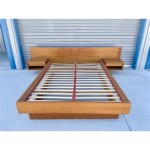Building a Murphy Bed: A Guide to Transforming Your Space
A Murphy bed, also known as a wall bed, is a space-saving furniture solution that seamlessly transforms a living space into a bedroom. It's a practical and stylish choice for small apartments, studios, or any room where you need to maximize floor space. While purchasing a pre-made Murphy bed is an option, building one yourself offers a rewarding experience and the freedom to customize it according to your specific needs and aesthetic preferences. This article will guide you through the process of building a Murphy bed, highlighting key considerations and steps to ensure a successful project.
1. Planning and Design
Before diving into construction, meticulous planning is crucial for a successful Murphy bed project. This involves determining the dimensions of the bed, its location in the room, and the desired features.
First, measure the available space where the Murphy bed will be installed. This includes the width, height, and depth of the wall. Consider the size of the mattress you plan to use, allowing for a comfortable snug fit. If the bed will be placed in a corner, the angle of the corner must be measured accurately.
Next, decide on the design of the Murphy bed. This includes the type of frame, the mechanism, and the aesthetic elements.
For the frame, consider using plywood or solid wood for durability and stability. The mechanism can be a simple hinge system or a more robust gas-spring system.
Aesthetically, choose a style that complements your room's decor. Paint or stain the bed to match the surrounding furniture and walls. Incorporate decorative elements like molding or trim to enhance the visual appeal.
2. Gathering Materials and Tools
Once the design is finalized, gather the necessary materials and tools. The specific materials will vary depending on the chosen design, but here's a general list:
Materials:
- Plywood or solid wood for the frame
- Mattress
- Hinges or gas springs for the mechanism
- Hardware: screws, nails, bolts, etc.
- Finish: paint, stain, or varnish
Tools:
- Saw (circular saw, table saw, or jigsaw)
- Drill
- Screwdriver
- Measuring tape
- Level
- Sandpaper
- Clamps
Ensure you have the appropriate safety gear, such as goggles, gloves, and a dust mask, to protect yourself during the construction process.
3. Constructing the Bed Frame
With the materials and tools assembled, begin constructing the bed frame. This step involves cutting and assembling the wood pieces according to the design.
Start by cutting the wood to the required dimensions using a saw. Ensure all cuts are straight and accurate for a sturdy frame. Utilize measuring tape and a level for precise measurements. Smooth any rough edges with sandpaper for a clean finish.
Next, assemble the frame using screws or nails. Pre-drill pilot holes to prevent wood splitting. Tighten the fasteners securely, but avoid over-tightening, which can distort the frame.
If incorporating a headboard or footboard, attach them to the frame using hinges or brackets. This ensures they fold neatly when the bed is raised.
4. Installing the Mechanism
The mechanism is crucial for the functionality of the Murphy bed. Choose a system that suits your needs and budget.
Simple hinge systems are cost-effective but rely on manual effort to raise and lower the bed. Gas-spring systems offer smoother operation and require minimal effort, but they are generally more expensive.
Attach the chosen mechanism to the frame securely, following the manufacturer's instructions. Ensure the mechanism operates smoothly and doesn't bind or stick.
Test the operation of the mechanism before proceeding to the final steps.
5. Finishing Touches
Once the frame and mechanism are in place, complete the finishing touches to create a beautiful and functional Murphy bed.
Sand the entire surface of the bed frame to achieve a smooth finish, eliminating any rough edges. Apply paint or stain according to your preference. Allow the finish to dry completely before proceeding.
Install any additional features, such as lighting, storage compartments, or decorative elements. Consider adding trim or molding to enhance the aesthetic appeal.
Finally, attach the mattress to the bed frame. Securely fasten the mattress to prevent it from shifting during use.
Test the bed's operation one last time to ensure it functions properly and is secure.
Building a Murphy bed is a rewarding project that allows you to customize your space with a highly functional and stylish piece of furniture. By following these steps, you can create a Murphy bed that enhances your home's aesthetics and maximizes available space.

Diy Wall Bed For 20 In A Camper Van Murphy

Diy Murphy Bed Tutorial And

Com Murphy Bed Queen Size Hardware Kit Diy Folding Cabinet Wall For Guestroom Easy To Build Made In Usa Home Kitchen

Diy Murphy Bed Project From A Kit Girl Just

10 Stylish Murphy Bed Chests That Are Perfect For Small Spaces

Diy Office Murphy Bed Guest Room Conversion We Completed The Look With Brand New Loloi Rugs X Jean Stoffer Design Area Rug And Throw Pillows This Is From Katherine Collection In

Her Diy Sprinter W Murphy Bed Nomad Life A Disability

5 Creative Ways To Use Murphy Beds In Small Spaces

How To Build A Diy Dual Murphy Bed With Charging Nightstand Closet Storage Crafted Work

Murphy Bed Stay Level Desk Hardware Overview Easy Diy Usa







